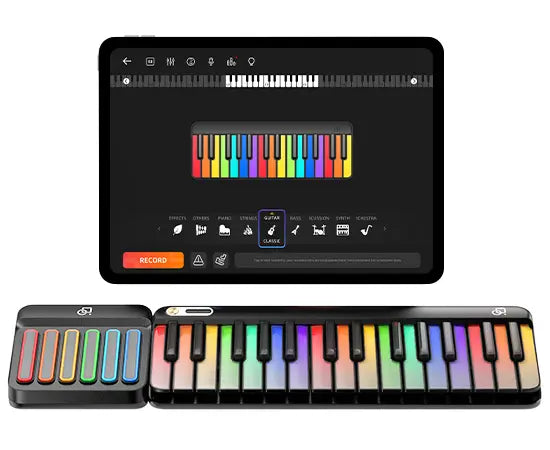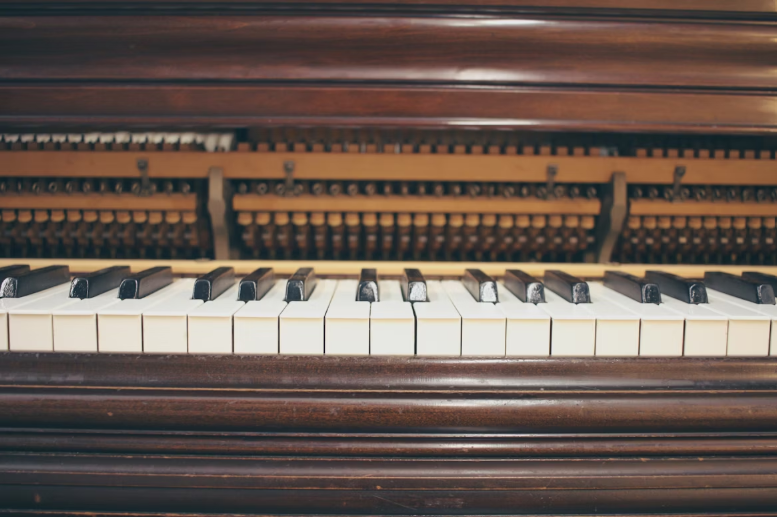You nailed that left-hand arpeggio—and then a five-day trip pops up. Momentum doesn’t have to disappear. With the right portable piano setup and short, focused routines, you can keep progressing anywhere: hotel, Airbnb, train, or airport lounge.
You’ve nailed that tricky left‑hand arpeggio at home, then a five‑day work trip lands on your calendar and—poof—momentum vanishes. Sound familiar? Learning how to practice piano while traveling means you keep hard‑won progress, strengthen muscle memory, and come home feeling confident instead of rusty. Two big mind‑shifts help:
-
Portability beats perfection. A lightweight practice piano keyboard is far better than no keys at all.
-
Short bursts count. Ten focused minutes in a hotel room can rival an hour back home, because distractions are lower and goals are tighter.
Pack the Right Travel‑Friendly Instrument
Modular Smart Keyboards

If you want a rig that doubles as a learning coach, check out the Smart Keyboard. The main 29‑key unit weighs just 1.43 lbs, runs on battery, and clips magnetically to an expansion board when you need a fuller range—pretty neat for cramped hotel desks. LED‑lit keys walk you through songs, and MIDI over Bluetooth lets you record sketches straight into your phone.
Why it shines on the road
-
True plug‑and‑play: Built‑in speaker plus headphones jack equals quiet late‑night practice.
-
Pocket‑size lessons: The companion PopuMusic app serves bite‑sized drills, so you don’t stare at blank keys wondering what to do.
Ultra‑Foldable “Carry‑On” Pianos
Prefer a full 88‑key layout? The aptly named Carry‑on Folding Piano 88 collapses to just 33 cm and weighs about 1.6 kg. It lasts up to eight hours on a USB‑rechargeable battery and even includes built‑in speakers and MIDI over USB. Toss it in a backpack, breeze through airport security, unfold at the Airbnb—done.
Quick Comparison
|
Feature
|
PopuPiano Smart Keyboard
|
Carry‑on Folding Piano 88
|
|
Keys (base unit)
|
29 (expandable)
|
88 full‑size
|
|
Packed size
|
13.3 × 4.8 in
|
13 in folded
|
|
Weight
|
1.43 lbs
|
1.6 kg
|
|
Battery life
|
Several hours*
|
≈ 8 hrs
|
|
Learning lights
|
Yes
|
No
|
|
MIDI
|
Bluetooth & USB
|
USB
|
Build a Micro‑Practice Blueprint
Flying day after day can blur schedules, so write a tiny daily plan before you depart. Here’s a sample 20‑minute routine that travels well:
-
Five‑minute finger warm‑ups – Silent “air piano” Hanon patterns while seated on the plane.
-
Ten‑minute repertoire spot‑work – Isolate two tricky measures; loop them slowly on your travel piano keyboard.
-
Five‑minute creativity burst – Improvise chord progressions or test new voicings; record ideas into your phone.
Lean on Apps & Headphones

-
PopuMusic App – Syncs with the PopuPiano; animated keys show fingering in real time. Great for sight‑reading newbies.
-
DAW‑lite platforms (GarageBand, BandLab) – Capture ideas fast, add drum loops, and keep practicing rhythmic precision.
-
Flight‑friendly headphones – Noise‑canceling models let you practice without bugging neighbors. Remember to pack the right adapter if your keyboard uses ¼‑inch outputs.
And one quick safety note: most airlines cap lithium‑ion batteries at 100 Wh for carry‑ons. Both keyboards above fall well within that range, but double‑check specs before you board.
Silent Technique Builders When Keys Aren’t Handy
Even the best “piano on the go” can’t follow you everywhere—think beach hikes or conference halls. Here’s how to sneak practice into those key‑less moments:
-
Isometric finger presses. Rest fingertips against your thigh, press firmly, release. Builds strength without a keyboard.
-
Mental playback. Close your eyes, hear each note of the section you’re memorizing. Research shows auditory imagery cements muscle memory almost as well as physical play.
-
Score marking. Annotate phrasing, fingering, and dynamics on a PDF score during layovers. You’ll hit the keys with a clear game plan later.
Manage Logistics Like a Pro
|
Scenario
|
Quick Fix
|
|
Airport security
|
Fold or detach your keyboard, place it flat in its own tray. Alert the officer it’s an electronic instrument—speeds things up.
|
|
Tiny hotel desks
|
Use a luggage rack as a makeshift stand; slip a towel underneath to stop slipping.
|
|
Power woes
|
Carry a universal USB‑C charger; both featured keyboards juice via USB, so no bulky adapters.
|
|
Humidity changes
|
Pack silica‑gel packets in the keyboard case to keep sensors happy.
|
Keep Goals Playful, Not Punishing

Travel is unpredictable. Flights delay, meetings overrun, relatives want to chat. Instead of a strict one‑hour daily target, set flexible micro‑goals:
Log one metronome‑filled run‑through of the piece’s trickiest passage.
Record a 30‑second improvisation every morning.
Meeting these mini targets breeds momentum and satisfaction—minus guilt.
Sample One‑Week Travel Practice Plan
|
Day
|
Focus
|
Tool
|
|
Mon (Flight)
|
Finger stretches + score marking
|
Tablet + stylus
|
|
Tue (Hotel)
|
Slow section looping
|
PopuPiano main 29 keys
|
|
Wed (Client site)
|
Mental playback during commute
|
Earbuds only
|
|
Thu (Airbnb)
|
Full‑range repertoire run
|
Carry‑on Folding Piano 88
|
|
Fri (Sightseeing)
|
Rhythmic clapping drills
|
Hands‑only
|
|
Sat (Downtime)
|
Record 4‑bar improvisation
|
Smartphone DAW
|
|
Sun (Return)
|
Review progress & set new goals
|
Notebook
|
Lean on Apps & Headphones
-
PopuMusic app (with PopuPiano): animated key guidance, short lessons, “Play & Sing” for chord-and-melody practice.
-
DAW-lite (GarageBand, BandLab): drop in a drum loop, practice to a click, and layer quick sketches.
-
Headphones: noise-canceling or closed-back keep sessions quiet; pack any needed adapters (⅛″ ↔ ¼″).
Bluetooth vs USB: Bluetooth is tidy for hotel coaching; USB gives the lowest latency for recording.
Final Thoughts
Frequently Asked Questions
Can I bring a folding 88‑key piano as carry‑on?
Most airlines count it as a personal electronic the size of a small laptop once folded. Confirm dimensions (≈ 13 in × 5 in) against the carrier’s under‑seat policy.
Will hotel Wi‑Fi handle MIDI over Bluetooth?
Bluetooth doesn’t touch Wi‑Fi bandwidth. As long as your phone or tablet is within 10 meters, latency stays minimal.
How do I keep up pedal technique without a pedal?
Use mental cues: tap your heel silently on the floor at each pedal mark while you play staccato on a table surface. You’ll retain timing even without sustain.
Are roll‑up silicone pianos worth packing?
They’re fun toys but lack velocity sensitivity and proper spacing. Go for a genuine practice piano keyboard—your fingers will thank you.






